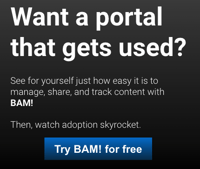There are four simple ways to lower costs of marketing collateral.
What if you could cut YOUR printed content budget by 25%? How about 50% – or more?
That could be a lot of cheddar. So why don’t people do it? Organizational inertia, maybe. Fear. Uncertainty. Doubt. Lack of knowhow. Perhaps all of those.
Well, if it’s a knowledge problem, there’s good news. It’s solvable, and this post gives you a straight line to some things you can do to make positive changes in your marketing budgets.
Faster
Sales reps spend 4+ hours per week looking for the right content.
Ignoring the obvious print production and shipping time wasted, digital content not only gives you much more agility to publish updates in real time, digital content delivered through a mobile sales tool gives your sales reps access to the most up-to-date content anytime, anywhere.
Cheaper
Manufacturers with revenue of $10 million spend $50K-$100K per year on printed content!
Manufacturers across the board are looking for ways to reduce their investment in expensive print.
More Measurable
89% of marketers ranked the ability to measure marketing impact as a top priority.
Digital content delivery engines give you the ability to track what content is effective and which dealers are most engaged with your product training and branding.
Yet, we have NOT gone paperless.
Although going digital has obviously changed the way we approach business, it has not done away with the use of print materials. Companies that have tried to go completely paper-free have discovered the downside of this approach, and some industries still rely heavily on printed materials. Sales reps know that showing or leaving behind a brochure or spec sheet provides a more effective experience for the prospective customer than saying, “it’s on the website.” It is very common to have stacks of brochures and spec sheets in showrooms, trade shows and events, making it easy for prospects to take information with them when it matters most. However, even with managed print services being more common now, these print costs are sky high.
Visit our Resources section for more helpful content on lowering marketing costs >
The benefits of going digital.
Print collateral continues to serve an important role for many companies, but it’s increasingly important to share current sales and marketing content online. In most markets, people turn first to the internet to find out more about your product or service, and it’s vital to have information there. This means that modern companies are faced with the additional complexity of having to manage multiple versions of brochures, catalogs, and spec sheets to make sure they’re available online as well as print. This duplication of content and its maintenance is frustrating and expensive for businesses — managing content on various platforms also invites inconsistency issues, and keeping the most up-to-date, accurate information available to sales teams is challenging.
Fortunately, there is a way to cut straight through this gordian knot.
On the sales floor, or at a trade show, the right mobile sales tool becomes a powerful marketing content delivery channel, wherever your sales rep goes. Not only can mobile devices be passed around in person like a brochure or spec sheet, but they also allow sales reps to easily present interactive material, such as videos, animations, and calculators. And if your prospect wants information to reference, that content can be emailed to them directly from the device.
Certainly the one-time cost of creating an app is not trivial, but consider the recurring cost of printing. What about the cost of ensuring your sales force, distributors, and dealers have up-to-date information? Or what about the transactional costs of fulfilling requests for print collateral? What about the loss of sales due to not having current product information? A mobile sales app, powered by a powerful marketing content management system, can help curb the financial investment, hidden or not, being poured into managing static content in multiple places, across multiple platforms.
Four ways to eradicate hidden costs.
Ask yourself if you are considering all the hidden costs of your current approach.
One: analytics.
“You can’t manage what you don’t measure.”
– Peter Drucker, management Yoda
Research tells us that 60% of marketing assets don’t get used, which is troubling enough. Most marketers don’t know which ones are being used, and which are being completely ignored. Producing marketing that that isn’t supported by analytics is like shooting in the dark. All you can do is guess.
In an age where 89% of marketers ranked improving the ability to measure marketing impact as a top priority, no marketer can afford to guess — you know it’s too expensive. Usage analytics showing which assets are getting used, when, by whom. It goes without saying that having analytics on what is getting used and how helps you stop wasting time creating the wrong materials is important. By spending time creating and distributing the right materials to the right audience, marketing increases value for the sales team.
Is it possible to get analytics like this? YES. Asset utilization analytics unlock the potential of sales enablement. Closed feedback loops help marketing create the assets sales needs to win more business, and then a virtuous cycle is established.
Two: Deliver up-to-date, print-ready materials
It’s uniquely challenging for OEMs to effectively communicate the complexity of their products. There is a heavy burden on the marketing team to manage and distribute the variety of marketing and sales materials required to support the product line. It is frustrating and costly to maintain the brochures and manuals for all products in a way that is easy for dealers and distributors to access.
Sales reps spend at least 4 hours a week looking for sales collateral. When you multiply this time by the number of sales reps selling, you can see that the overall cost of wasted time is a huge, unnecessary burden. No wonder they are using outdated materials! Your sales reps probably gave up searching for the current version of assets when they couldn’t easily find the right ones. Maybe they had some brochures and manuals of last year’s models, but can’t remember where the ones for this year’s products are. They simply threw up their hands and continue to use old, increasingly outdated versions of product literature, manuals, and spec sheets, or they repeatedly seek support from Marketing to find the right thing.
Or maybe they gave up on the marketing materials entirely, relying on their knowledge of your product line. This knowledge may be inaccurate, but with the effort sales reps face in order to find the correct assets, can you blame them? Nowadays, print and email aren’t good enough for the modern marketer. A dealer portal may seem like a good solution on the surface, but these are expensive to maintain and, user reviews suggest, aren’t the easiest to use.
Three: Save on training costs
Surely you have some superstar sales reps — but what about the rest? It takes 8–12 months to get a new sales rep fully up to speed in an OEM selling environment. It can often take much longer. There is so much product information to learn, the product line is so complex, it may not seem like there is a way to speed it up.
Using stacks and stacks of paper is not helping!
One of the reasons sales training is so time-consuming and inefficient is how the training is done. Outdated training materials, lack of available training and inconsistent methods result in a poor learning experience for new sales reps. The new rep and the company both experience negative consequences as a result. How much does it cost to train new reps in your organization? How many do you onboard per year? If you could onboard them in half the time, meaning they could get to quota twice as fast, what would that be worth?
Four: Save costs on printing by using a mobile sales app.
It’s difficult to measure, but those costs are there. Even when we take hidden costs out of the equation, the investment in a mobile sales tool can pay for itself surprisingly fast when just considering just printing costs alone. For example, if you are at a company with 60 products that are updated two times a year, and you have 20 dedicated salespeople, 10 dealer/distributors, and 500 customers who receive product literature directly, investing in a mobile sales enablement tool would pay for itself in three years (with a positive 5-year NPV). It’s a greener option, with less management and coordination overhead, and your sales staff always has access to up-to-date information in a way that’s easy to share with customers.
Would you like to know how much time and money a sales enablement solution can save your company? Download the Sales Enablement Tool Cost Model and we’ll show you the incredible potential of a sales enablement solution.
Is a sales tool right for your company? It all depends on your situation.
Sales enablement exists to empower sales reps to focus on what they do best — sell. Marketing content management enables your company to give your sales reps what they need, when they need it, without breaking the bank or creating an administrative nightmare in version control. You should pick a tool that suits your sales and marketing teams needs.
If a sales tool is something that will save your company money, contact us today and learn how our BAM! Dealer Engagement Platform can help your business grow.
Additional resources:
- Check out the many features available in the BAM! sales enablement platform
- If you are ready to see it live, book a demo


